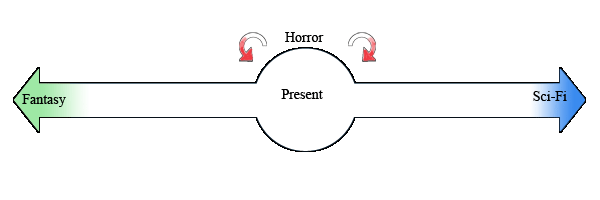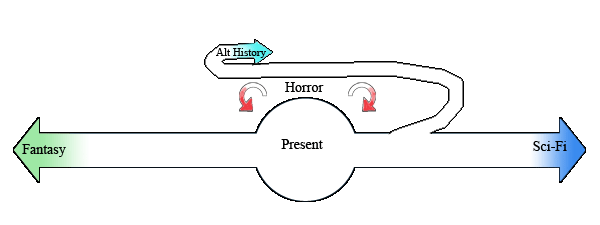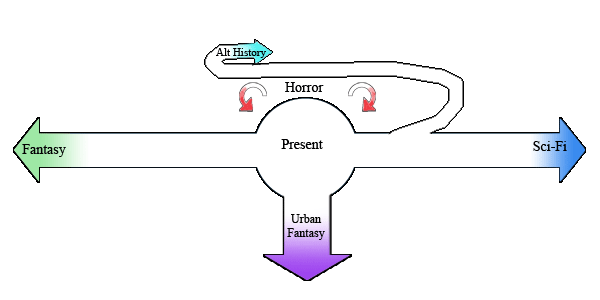I am not really a fan of the steampunk genre, but I am very excited to see it doing so well.
Why? Well, let’s take a little trip down memory lane. When I started reading science fiction and fantasy, I looked upon the genres as existing on a speculative timeline. Science fiction stories were stories in the future following along one technological/sociological path or another. Fantasy stories were stories set in some mythical past, a medieval Europe that we’d like to believe might have existed if only THE MAN hadn’t stamped magic out of all the history books. Even horror existed on this timeline as well, making little circles around the present as tales that could be happening in the near present yet only showing up on the police report in the Tuesday paper.

I liked it. It was a neatly contained metaphor for the larger speculative fiction genre. SF is over there on the right, and all those epic fantasies are over there on the left, while the horror folks are in the middle, shambling one step ahead of the zombies. All the genres had their place, and every genre was staying in that place. Truthfully, I doubt it was really ever that simple, but for me at least, it was an innocent delusion.
Alternate history was the first crack in my lovely façade. Robert E. Lee got himself an AK-47, and the modern island of Nantucket was relocated to the twelfth century B.C. From there things flowed forward as you would expect… well, not really as you’d expect, come on! But at least the tales stuck with real world physics. There was no magic driving the plot forward, just good old gunpowder and steel. I could imagine that as an odd split off of SF. It was merely a more fully developed time travel genre without all the angst over paradoxes. My nice little timeline adjusted to allow for this SF throwback.

Then came urban fantasy. It wasn’t the epic fantasy of old with elves, swords, and vast battles against the goblin king’s army. In that respect, I’m going to lump Harry Potter and some of the other modern YA fantasy into this pile as well. These stories are taking place in a modern setting with fantastical elements. In many cases, e.g. Dresden Files and Harry Potter, these fantastic elements are behind the scenes of the larger world. We the readers are getting a glimpse of the magic that the authorities keep telling us does not truly exist. I tried to cram that into my timeline and figured it was a bit like the horror genre. It was happening now, just that we were only seeing the fringes of it.

But as I read further, some of these fantasy worlds held the fantastical elements out for all to see. Perhaps they were set in the near future after some big event triggered magic’s resurgence in the world, or maybe they were set in the current year with that big event decades in the past. Or perhaps the fantastical elements are grafted on wholesale to our world, and we simply have a very different history of fighting the necromancer Hitler and his horde of genetically superior zombies, leading us to a world where we’re regretting our decision to ally ourselves with the Lycan empire and the former Ukrainian republics.
Those tales pretty much shattered my notion of a timeline, because there was nothing linear about this. These tales of fantasy could no longer be considered the little horror-like swirls hiding beneath the surface of the present. They were clearly a new direction, but at least they were centered on the present. It let me look then on the timeline as a present-centered story universe and had me wondering where else we might go from here.

But then steampunk came along, and I had to say WTF! (Or as my wife is fond of saying, “Whiskey Tango Foxtrot!”) There is nothing present-based about steampunk. It’s not even really historically based. It’s the Victorian age that never was. I can’t even call it alternate history, because they’re not taking some future or present science and taking it back. Instead, steampunk has taken science and technology that never really was and made it as real as science fiction’s phasers and warp drive. This left me with only being able to describe steampunk as a hard left turn. It waves to Queen Victoria and goes off in its own direction.

And it’s heading the direction of some fairly rich destinations. I have run into odd variations that mix in magic, horror, and the paranormal. Some even take steampunk into future directions – not future from our present, but steampunk plus eighty years. Dieselpunk? Biopunk? Who knows where this is going?
As I said at the beginning, I’m not really a fan of steampunk, but I am very excited about steampunk. These kinds of hard turns from the narrow boundaries of the various speculative fiction genres not only provide fertile ground for telling new stories, but they rattle the notion that our genres should even have boundaries. Cross-genre tales used to be impossible to market because we couldn’t figure out where to stick them in the bookstores. Now cross-genre is the fertile flood plain between the banks of our old genre rivers.
There’s an old maxim that there are really only two stories, or is it three, or perhaps twenty-seven, but as we keep reusing archetypes and journeys and a young hero’s coming of age, we are to some degree retelling stories we’ve all heard a hundred times before. This maxim tells us that all the rest is just window dressing. But if so, I’m very happy with the new curtains.






